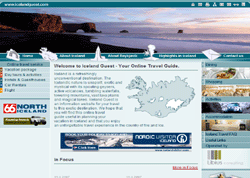Iceland Tourist Guide, General Information
With the rise of Iceland as a premier tourist destination of the world, there is more and more interest amongst travelers from all over the globe to learn more about this enchanting North Atlantic country situated in the western most part of Europe. Most search engines report a rising number of search queries asking for more information about Iceland - from general facts about Iceland, to its history, culture and of course places of tourist interest.
As an ongoing feature in providing more information for tourists who are interested in Iceland, we shall first look at the general information of Iceland.
Independence
Iceland officially gained independence on 17th June 1944 from Denmark with the repealing of the December 1918 Act of Union. During the 2nd world war since the German troops occupied Denmark, the British troops landed in Iceland in order to stop the Germans from taking over the country. At around the same time people of Iceland demanded more control over their country and thus got official independence on 17th June 1944.
Government
The President of Iceland is Mr. Olafur Ragnar Grimson (since 1 August 1996) and the
Prime Minister is Mr. Geir H. Haarde (since 7 June 2006)
Capital
The capital of Iceland is the charming city of ReykjavÃk which has all the qualities of a great city but at the same time has an abundance of unspoiled natural beauty.
Population
Iceland has an estimated population of three hundred thousand (300,000) with almost about two hundred thousand people (200,000) living in or near the capital city of ReykjavÃk. Population density is one of the least in Iceland with only 2 people per square kilometer • 1.2 persons per square mile. 91 percent of the population live in urban areas whereas 9 percent live in the rural areas.
Religion
About 86% of the people in Iceland follow the Evangelical Lutheran church.
Landscape
Iceland has a total area of about 103,000 km² or 39,756 sq. mi. Most of the island is covered by a large plateau. The coastal areas are quite grassy lowlands allowing the people to live, grow crops and graze sheeps etc. The inland plateau is rugged and barren and about 2500 feet above sea level. A fault line runs across Iceland which gives rise to volcanoes, hot springs, steaming geysers, glaciers, and radiant lava fields.
Weather
The weather in Iceland, contrary to popular belief is quite moderate. The Gulf Stream keeps the ports warm and free of ice throughout the year. Average temperatures range from 12 degrees centigrade in July at ReykjavÃk and are a bit warmer in the north and east of Iceland. There is not much snow in ReykjavÃk even during the winters but the north and east sides along with the West Fjords receive a heavier snowfall.
Language
Official language of Iceland is Icelandic but most of the population especially those in their teenage years through to people in their fifties speak fluent English
Currency
The Icelandic monetary unit is the krona (plural kronur) (ISK). The coins come in 5 denominations of 100kr, 50kr, 10kr, 5kr and 1kr. The bank notes come in 4 denominations of 5000kr, 2000kr, 1000kr and 500kr.
Author: Dagur Jonsson
Dagur Jonsson is the editor of Iceland Guest, a website specializing in tourist information for travelers to Iceland. For more information visit www.icelandguest.com

